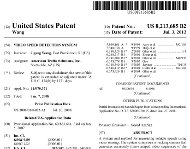7/6/2012
Traffic Camera Vendor Introduces New Measurement TechnologyPatent granted for vidar, a video based speed camera measurement system.

Old technology has become new again as American Traffic Solutions (ATS) on Tuesday received a patent for a photography-based speed measurement system that dispenses with the need to use lasers, radar or in-pavement sensors to generate speed readings. ATS calls the system "vidar" because it uses video sensing to estimate vehicle speeds.
Fixed speed camera systems are commonly installed with lines on the pavement marking a fixed distance. By using time-stamped photographs or video, it is possible to calculate how long it took a vehicle to travel the given distance. This provides a secondary speed verification to go along with the laser, radar or pavement sensor reading. The vidar system envisions a more powerful camera operating without any sensors able to track multiple vehicles. Built-in optical character recognition, maximizing the number of tickets issued.
Though ATS received a patent for this discovery, the very first speed cameras developed in Europe in 1901 and used in Boston, Massachusetts as early as 1910, were built on the same premise. Instead of using computers and video, the devices exposed an image (or images) of a vehicle at two points along with a physical stopwatch in the frame. ATS claims its implementation of this idea is unique.
"Because the recorded image frames are exactly the same frames that could be used to calculate the vehicle speeds at roadside, the system can reproduce the same speeds for the vehicle whether the calculation is done roadside or at a later time," the ATS patent application stated. "Therefore, unlike any other speed measuring device, the system according to embodiments of the invention may provide a method for obtaining verifiable vehicle speed information."
In defending this invention, ATS acknowledges the limitations of existing speed camera technology.
"Although radar is accurate in determining the speeds of relatively isolated vehicles, it is less effective at differentiating various vehicles in a cluttered environment, due to the relatively large beam size," the applications stated. "In addition, personnel that operate speed measuring devices are usually required to receive proper training on the correct operation of the devices. However, even with all the precautious procedures to ensure proper functioning of speed measuring devices in place, measurement errors are unavoidable due to the intrinsic limitations associated with each speed measuring method."
Vidar is not without its own potential accuracy problems. Because the system relies on precise timing, an internal clock error could produce bogus speed measurements. That is exactly what happened in Victoria, Australia when innocent drivers received tickets due to improper clock synchronization.
ATS trademarked "Vidar" in August 2008, but the Patent and Trademark Office declared the trademark abandoned on December 6, 2011. ATS acquired the Vidar technology from Nestor Traffic Systems, a firm that ATS bought after Nestor became insolvent.


